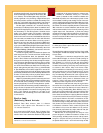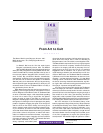
ing a number of successful mainstream films such
as Waterloo Bridge (1930), Showboat (1936), and
The Man in the Iron Mask (1939). But it is his
wildly popular horror films – Frankenstein (1931),
The Old Dark House (1932), The Invisible Man
(1933), and The Bride of Frankenstein (1935) – for which he
is chiefly (and rightly) remembered. (The title of Gods and
Monsters is taken from a scene in Bride, in which Franken-
stein’s assistant, Dr. Praetorius, toasts Frankenstein’s brave
new world of god-like scientists and their creations.)
In the early Forties, Whale fell out of favor with the studios
and the public. Whether because of his sex life (he was openly
gay at a time when gay Hollywood was deeply closeted), or,
more likely, a series of failures at the box office, he retired from
filmmaking into genteel disgrace – living a life of dilettantism
and dalliance that ended when a series of strokes incapacitat-
ed him in 1956. In the following year, Whale drowned himself in
his backyard swimming pool, leaving a note for his ex-lover, the
film producer David Lewis (Arch of Tr i u m p h, Raintree Coun -
t y): “The future is just old age and illness and pain.... I must
have peace and this is the only way. ”
Director Bill Condon, himself a dabbler in horror films
(Strange Invaders), has taken this cautionary tale of Holly-
wood excess and managed to fashion it into something a good
deal closer to Death in Ve n i c e than Death in Brentwood.
Indeed, the film is a triumph of style, producing, at its wordless
denouement (and in a final wordless scene following its
denouement), an ache of genuine sadness the likes of which I
h a v e n ’t experienced from a film in many a year.
How Condon has done this is chiefly a matter of four
notable successes: a hauntingly beautiful score commissioned
from composer/arranger Carter Burwell; an unusually intelli-
gent and inventive script (that Condon himself wrote, based
upon Christopher Bram’s novel, Father of Frankenstein); a
visual style that perfectly matches the intelligence and inven-
tion of the script; and, finally, what was and will remain – so
beyond doubt, question, or debate that the voting contingent of
A M PAS ought to have its collective membership revoked – the
finest performance of the year by an actor in a leading role. Sir
Ian McKellen, who is himself openly gay (the first openly gay
Britisher to be knighted), brings this sad, witty, complex man to
the most vivid life imaginable. It is the role of a lifetime and a
c a r e e r-crowning achievement.
Like Mrs. Brown, Gods and Monsters is about the myster-
ies of love and friendship, but it is also very much about the
ways art and life grow knotted together, like vines in bark.
Indeed, as in the novel it is based on, the film attempts to under-
stand Whale’s life and death as variations on the very story that
Whale himself made famous on film – F r a n k e n s t e i n.
At times, the parallels to the novel (and Whale’s version of
i t ) makes this extremely well-crafted film seem somewhat
overwrought, as if Condon were intent on having every shot of
every scene answer to some aspect of the myth. For example,
in his excellent commentary track on the DVD, Condon talks
about how he deliberately photographed Brendan Fraser in bits
and pieces through the opening credit sequence – his feet, his
face, his torso, never his whole body. The point being that Fras-
e r ’s character, Clay, is like the monster – inchoate, just parts –
until he meets his “creator” in James Whale, who “reassembles”
him into a “whole” person.
While this sort of thing is tough to see on the screen (even
when you know it’s coming), it says something about the wit
and subtlety with which the film was made. And without doubt,
that wit and subtlety – and, yes, Condon’s overriding metaphor
– pay off emotionally. I have rarely seen a film in recent years
that is so intricately crafted to such powerful effect.
Gods and Monsters begins in 1957, after a series of mild
strokes has already begun to take a heavy toll on Whale physi-
cally and mentally. Haunted by bad memories and the nearness
of death, Whale attempts to maintain his spirits and his sanity
by doing what he’s always done – flirting, drawing, trying to
preserve the illusion that his life is as orderly and urbane as it
once was. It is through flirting that he meets Clay, a tall hunk of
a gardener, fresh out of the Marine corps, with a handsome,
square-jawed, high-browed face and huge physique that
reminds Whale (and us, a little) of Frankenstein’s monster.
Whale pretends that he wants to use Clay as a model for his
sketching (although, as we find out late in the film, Whale’s
mind is so disordered that he can no longer sketch). Once he
discovers that Whale is the director of the F r a n k e n s t e i n f i l m s
– “Just the first two,” Whale notes, with characteristic asperity.
“The others were done by hacks.” – Clay agrees to pose.
The exceptionally naïve and very straight Clay truly believes
that Whale is interested in him as a subject – as a person – and
is flattered by the attention. To Clay, Whale represents a life, a
level of culture, that he’s seen only in movies. (His own life is an
aimless ruin.) Even after he learns that Whale is gay, he contin-
ues to sit for him, although the thought that Whale may be see-
ing him as a sex object (which Whale innocently denies) clearly
upsets him. It’s as if Whale were a god, and Clay his grateful,
adoring creature – eager to learn, eager for friendship. The par-
allel with the Frankenstein story is patent.
Whale, who has only been pretending to sketch the boy in
order to get him to take off his shirt and have some fun ogling
him, begins, almost against his will, to talk to him candidly.
Whale explains this sudden candor by saying that there is
“something about your face that brings out the truth,” only it is
not Clay’s face but his trust that makes Whale so helplessly sen-
timental. That trust reminds Whale of another boy who trusted
him absolutely – a secret from the past which is not told until
late in the film.
Whale as Frankenstein and Clay as his Creature are scarce-
ly the only parallels this film draws between life and art. Con-
don is intelligent enough to see that Whale was both Franken-
stein a n d the Creature – both a creator of mythic films about
monsters and himself a charming monster, born of wishful con-
fabulation and sheer will power.
W h a l e ’s miserable youth, which he spent a lifetime repress-
ing, is presented in flashback memories during his talks with
C l a y. Born of a poor family in northern England, he was, as he
later confesses, like a “giraffe given to a family of farmers. What
could they do but hook the giraffe up to a plow?” Rejected by
his father, who despised his effete manner and artistic ambi-
tions, he was forced out of school and set to work in a factory
while still a boy.
W h a l e ’s experiences in the First World Wa r, also presented
as flashback memories, made him – and destroyed him. As an
officer in the trenches, he adopted the manner of the upper
crust and discovered his talent to direct men. He also had a
homosexual affair with a handsome young adjutant, who
adored him and whose horrible death (and the terrible imprint
it left on Whale) is the guilty secret at the heart of the film.
In Hollywood, Whale the director managed to reinvent his
past, as so many in Hollywood have done. Like Frankenstein


















